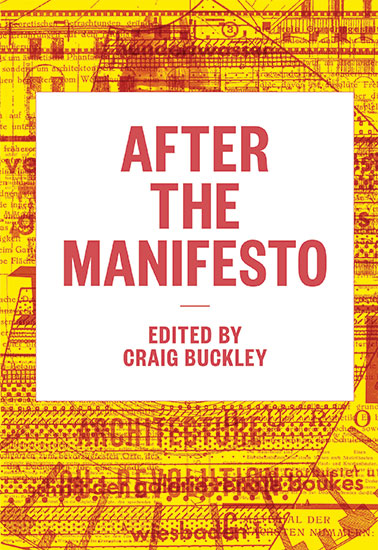After the Manifesto: Writing, Architecture, and Media in a New Century, edited by Craig Buckley, Columbia GSAPP Books on Architecture, March 2015, 176 pages,(paper) $35.
The first lines of Craig Buckley’s introduction to this collection of essays from the proceedings of conferences on the subject of manifestos at Columbia and the University of Navarra in 2012, seem surprising. “There has been something like a mania for the manifesto in recent years,” he writes. After an absence, “Today we seem to be surrounded by them.” Surrounded? I hadn’t noticed a single one.
Buckley reports a variety of events from 2008 through 2014 that elicited architectural calls to action in manifesto form. Although he provides a solid list, the events he cites were held at minor if respectable venues from New York to Istanbul. Many associated revolutionary texts were also published, in print or online. Yet they reinforced my qualms about the manner in which contemporary architects effect change. After weighing the essays in the book—by architecture figures such as Beatriz Colomina, Mark Wigley, Bernard Tschumi, and their counterparts at Navarra—my qualms turned to skepticism.
If someone inhabiting my own small media niche, at most one subculture away, could entirely miss this “mania for the manifesto”—and indeed all of the writings themselves—it does more than signal a fundamental decline in the utility of that vehicle of persuasion for architects: it is confirming evidence of the broader rift that calls into question the power of any traditional form of communication to encourage big, pancultural change in a world defined by vast forums for communication and the resulting isolation of its cultural centers.
The manifesto, in its 20th-century heyday, relied on the press for its relevance. Several contributors to Buckley’s book celebrate the fact that when “Le Futurisme” was published in 1909, it sprawled over the front page of Le Figaro. Seen at once by many thousands, the piece of writing we know as the Futurist Manifesto did come to change the way we—the biggest we, not the little we in direct professional engagement—see and make art and buildings.
Yet few essays in After the Manifesto address the fact that the infrastructure or platforms that allowed would-be revolutionaries to shout effectively beyond their own subcultural frontiers no longer exist.
Failing to engage with the shared experience through social media we all now take for granted—although Colomina discusses the internet before she punts—the publishing effort remains decidedly historical. We never get a sense of the present or a glimpse of the future.
It’s a missed opportunity. The only relief in our lives from the isolation of the new normal is a fleeting and occasional echo of a lost communal space that presents itself in our mass-consumed virality (e.g., “going viral”). This phenomenon is so exceptional and dear precisely because it holds the promise of a unifying experience, consolidating intention and catalyzing change across subcultures. Denied the paths manifestos once traveled, no words about architecture will ever wield so much power again. Yet, whether rendered or photographed or filmed, architecture still can break through.
So, architects, let your buildings be the messengers of your ideas. No one is reading your manifestos.

